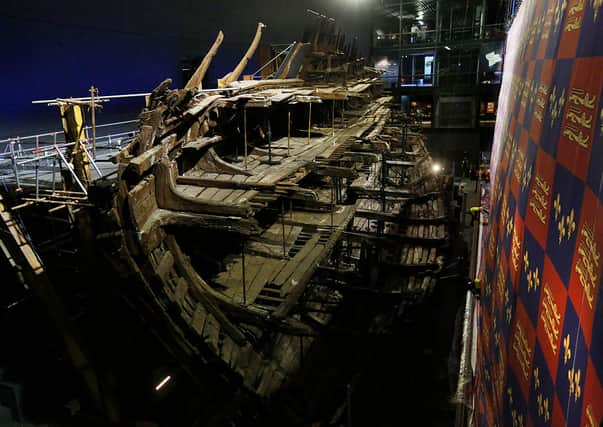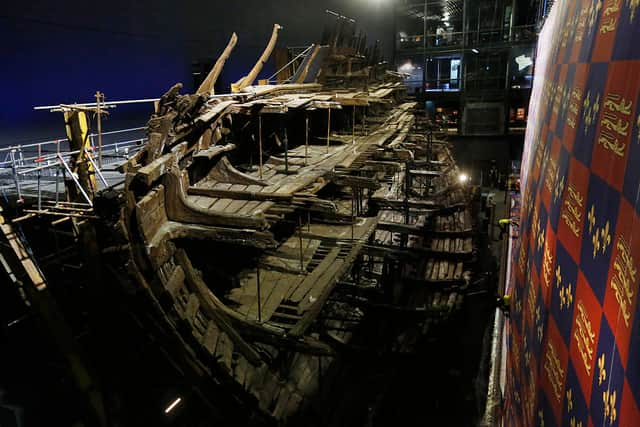Where is the Mary Rose? Ship location, is it in a museum, when was it raised in Portsmouth, where did it sink?


Memories of the Mary Rose's raising from the Solent seabed are being sought 40 years after Henry VIII's flagship was recovered from the water.
Millions of TV viewers witnessed the first time in 437 years when the timber framework was hauled to the surface.
Advertisement
Hide AdAdvertisement
Hide AdThe project was spearheaded by King Charles, then Prince of Wales. The Mary Rose Museum is seeking people's memories of the event for an anniversary blog.
Here is everything you need to know about it.
What was the Mary Rose?
The Mary Rose was a successful warship that served King Henry VIII for 34 years. She sank during the Battle of the Solent in 1545 resulting in the deaths of the vast majority of her crew.
The vessel sank while spearheading an attack on a French invasion fleet, with Henry VIII watching from nearby Southsea Castle. Approximately 500 soldiers and sailors were killed.
The wreck’s location had been discovered on the seafloor in 1971, around 40 feet (12 metres) deep. Four years later in 1975, accomplished diver King Charles III spent 47 minutes underwater examining the wreck of the flagship.


Advertisement
Hide AdAdvertisement
Hide AdIn 1982, 437 years later after she first sank, the remains of the Mary Rose and 19,000 artefacts were recovered, and many are preserved and displayed in Portsmouth Historic Dockyard.
The ship has been dubbed a "Tudor time capsule," with thousands of artefacts on board including weaponry and personal belongings of the crew, which are now on display at the museum.
The vast archaeological and engineering undertaking of raising the vessel was one in which King Charles took a personal interest.
It is thought as many as three of the eight crew of the Tudor warship may have originated from southern European coasts, Iberia and North Africa.
Advertisement
Hide AdAdvertisement
Hide AdResearchers say the remaining five crew members were likely to have been brought up in western Britain, with further analysis suggesting one of these men was of African ancestry.
Where did the Mary Rose sink?
The Mary Rose sank in the Solent, the strait north of the Isle of Wight, just off the coast of Portsmouth.
The ship had actually been found over 100 years earlier than its 20th century rediscovery, when in mid-1836, a group of five fishermen caught their nets on timbers protruding from the bottom of the Solent.
Two professional divers were hired, and used recently invented rubber suits and metal diving helmets, to examine the wreck and salvage items from it, including several bronze and iron guns.
Advertisement
Hide AdAdvertisement
Hide AdThe ownership of the items caused a dispute between the divers and the fisherman who had hired them, an argument that was settled with an agreement to allow the fishermen a share of the proceeds from the sale of the salvaged guns.
Where is it today?
The wreck was transported to an atmospherically controlled dry dock and sprayed with a mist of cold water, followed with water-soluble wax, before an air-drying procedure began.
The Mary Rose is presently kept in a £39 million purpose-built museum in Portsmouth Historic Dockyard, where visitors can view it through floor-to-ceiling windows and stroll along a balcony accessed by an airlock.
The Mary Rose Museum is asking individuals to share their memories of where they were on 12 October 1982 - the date the wreck was raised - on their blog.
Advertisement
Hide AdAdvertisement
Hide AdIn 2020,the remains of the flagship were said to be in “mortal peril” after the museum closed its doors to visitors amid the Covid-19 outbreak, according to the charity’s chief executive.
Helen Bonser-Wilton, chief executive of the MaryRose Trust, warned that the “clock is now ticking” on the museum’s survival. She explained that 90% of its funding comes from visitors, with the majority generated between April and September.
Though things have since eased and access to the wreck is no longer restricted, the public can continue to support the museum through its website at: www.maryrose.org/support-us.
Comment Guidelines
National World encourages reader discussion on our stories. User feedback, insights and back-and-forth exchanges add a rich layer of context to reporting. Please review our Community Guidelines before commenting.
